Following a month-long saga in which he was linked with numerous top clubs across Europe, Bruno Guimaraes signed a four-and-a-half-year deal with Olympique Lyon on January 30th. Lyon managed to secure the services of the highly-rated midfielder who currently captains Brazil’s 2020 Olympic side.
The belief that Lyon’s hierarchy have in the talent of the 22-year-old played no small part in convincing the talented youngster that Lyon, and Ligue 1, would be the right destination for him to continue his footballing development. Brazil and Lyon legend turned sporting director, Juninho Pernambucano played no small role in courting the promising midfielder.
As a result, Les Gones prevailed above other interested parties, namely Atlético Madrid and Arsenal, both of whom were rumoured to be heavily interested in securing the services of the player this past month.
It is clear that Lyon have a lot of faith and with that, expectation, for their new signing. They are not alone in holding Guimarães in high esteem. Guimarães earned a reputation over the past couple of years as one of Brazil’s most promising young midfield prospects.
In this tactical analysis piece, we will analyse Guimarães’ style of play along with some of his key traits. Furthermore, this scout report will analyse how Guimarães may slot into Lyon’s team and what his role could be in Lyon’s tactics.
Bruno Guimarães’ ball-carrying ability
One of the key aspects to Guimarães’ game, is his ability to progress the ball up the pitch. Guimarães is excellent at linking the defence to the attack rather quickly. One of the ways that Guimarães often progresses the ball up the pitch is with his ball-carrying ability.
Though he often plays in a defensive midfield role, Guimarães is not a player who generally sits back in the attacking phase. Instead, he is frequently afforded the freedom to roam forward in support during the attack, as another midfielder sits back instead.
Guimarães is a player who constantly has his head up, looking to progress the ball forward. He does this through either his passing or, as we’ll discuss now, his dribbling ability.
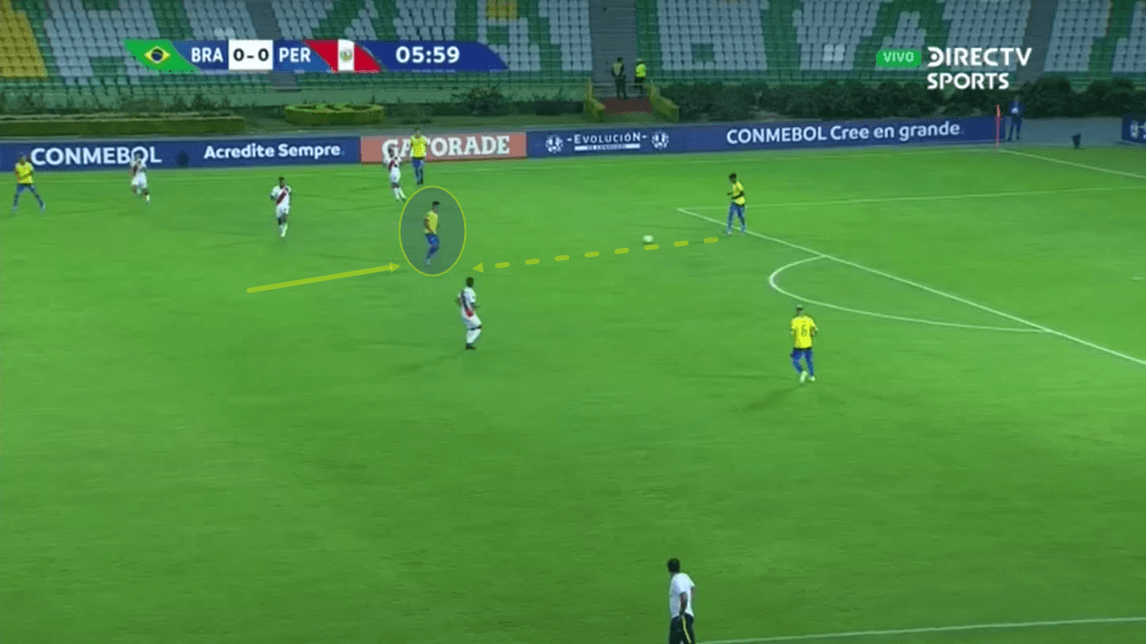
When playing out from the back, Guimarães often drops deep from the midfield in order to pick the ball up short from his centre-backs. We can see an example of Guimarães making this particular movement during the build-up in the image above.
Guimarães provides his centre-backs with a simple short-passing option by dropping to collect the ball deep. As he receives the ball, Guimarães can subsequently turn and progress the ball up the pitch, driving towards the opposition half.
Guimarães receives the ball and progresses it up the pitch with a sense of urgency. He is a player who is constantly trying to move the ball forward and create problems for the opposition.
Guimarães constantly offers his side energetic off-the-ball movement as he tries to offer a progressive passing option. Furthermore, when you watch him receive the ball, he always does so with his head up looking for other progressive passing options.
Guimarães offers his teams an attractive option as he drops deep to receive the ball here. Firstly, his quality on the ball makes him comfortable dropping deep to play out from the back. Furthermore, his ball-carrying ability allows his team to quickly play past the opposition’s first line of defence quite quickly. Guimarães’ ball progression can often be vital in helping his side to kickstart attacks.
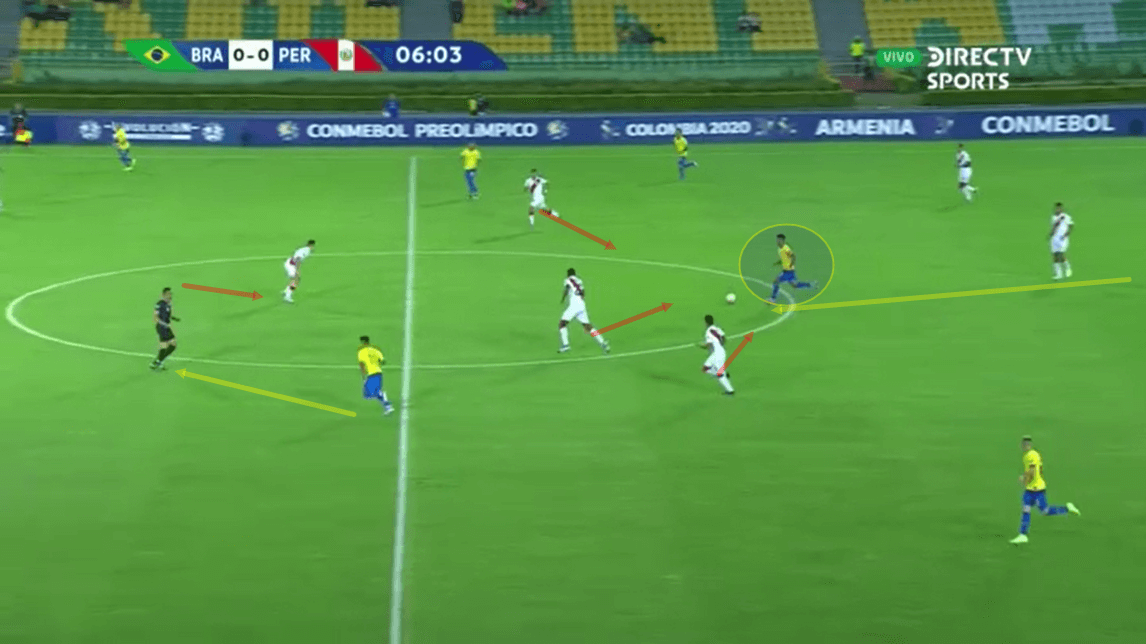
As this passage of play unfolds, we see Guimarães quickly progress beyond the opposition’s first line. As he progresses into the midfield while dribbling at pace, he causes concern among the opposition’s midfield. This second image shows us how Guimarães’ threatening dribbling ability while playing out from the back subsequently draws the attention and movement of four opposition midfielders towards him.
As Guimarães’ dribbling ability draws the opposition towards him, this creates space for his supporting teammates. In this image, we can see that as Guimarães progresses up the pitch, his full-backs move with him in support. Furthermore, we can see that Guimarães’ two ‘8’s also offer support either side of him in slightly more advanced positions.
Guimarães’ supporting teammates enjoy an increased amount of space due to his ball-carrying quality in the build-up. As this passage of play moves on, we see Guimarães distribute the ball long, up to the left-wing. The left-winger receives this pass and continues the Brazil attack.
This attack provides us with an example of the danger that can be created from the build-up, primarily by Guimarães’ ball-carrying ability. Guimarães is an excellent player to have in your midfield when playing out from the back. His ball-carrying ability is an excellent asset to beat the opponents’ press and quickly create attacks.
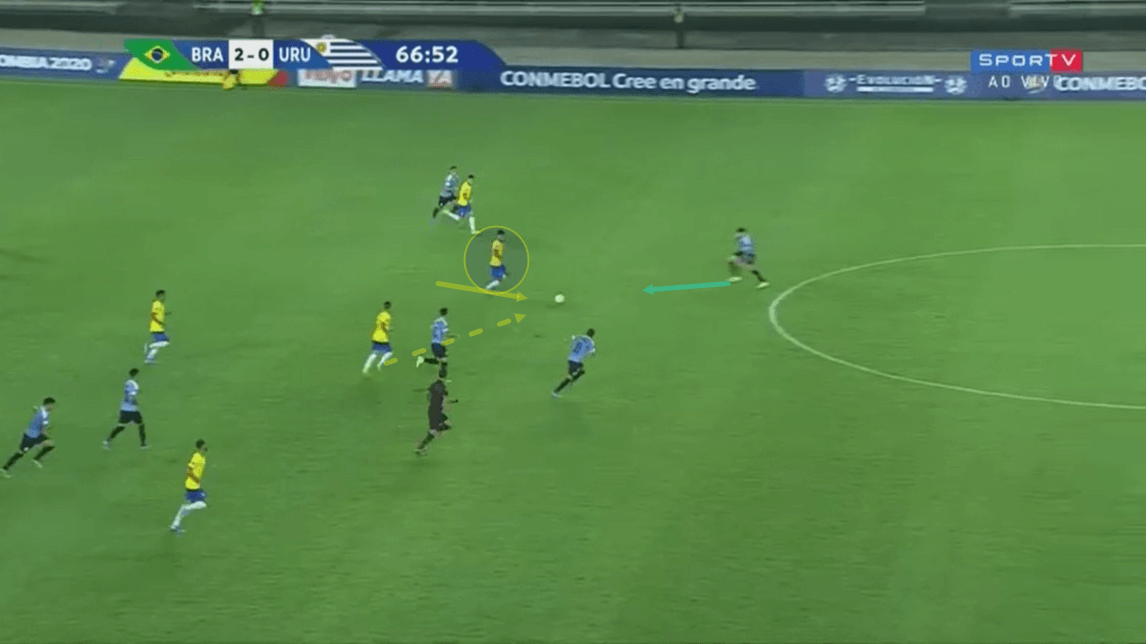
This next image shows us another example of how Guimarães’ ball-carrying ability can help his side when transitioning from attack to defence. In the image above, we can see Guimarães, who is circled here, running onto the end of a teammates’ pass. Guimarães’ Brazil side are attempting to start a counter-attack at this particular moment.
As Brazil attempt to counter-attack here, the opposing Uruguay side attempt to deploy a counter-press. They had committed a large number of men forward during the attack, some of whom we can see tracking back towards Guimarães here. Furthermore, we can also see a deeper Uruguayan player beginning to aggressively press the approaching Guimarães.
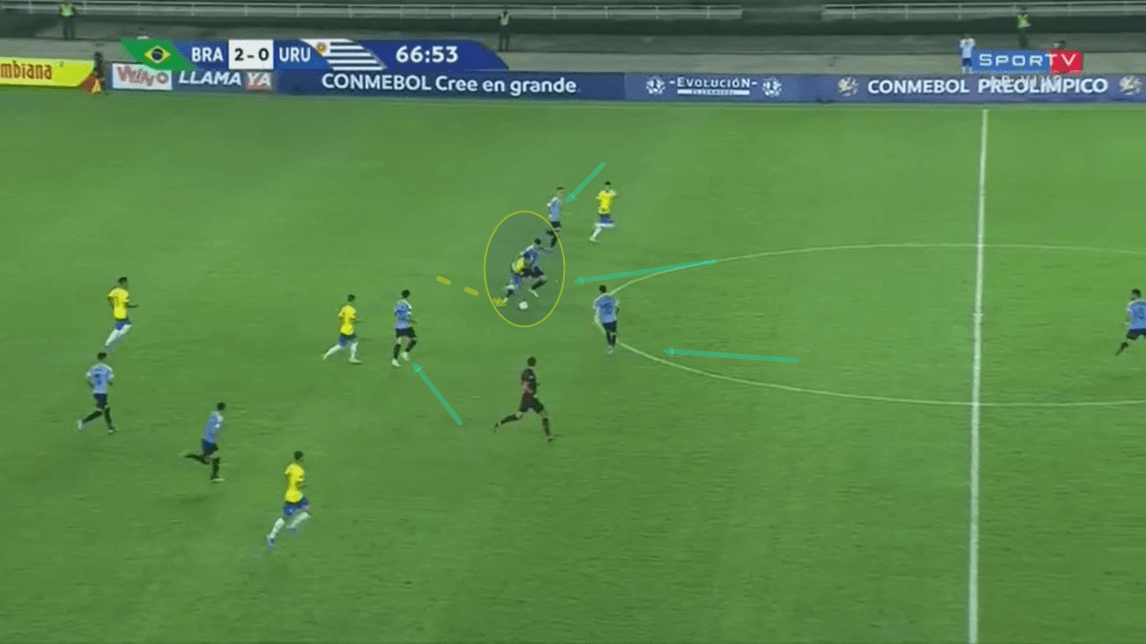
As play moves on, Guimarães receives the pass from his teammate and decides to take the Uruguayan defender on. As he does so, he uses his agility and dribbling quality to draw a foul from the pressing Uruguayan defender. As Guimarães intelligently draws a foul from his opponent, he essentially puts a stop to the opposition’s counter-press. This allows Brazil to regroup, get back into their shape and start the attack with possession.
This passage of play shows us an example of another key aspect of Guimarães’ game, his ability to draw fouls. In addition to being able to carry the ball past the opposition press, another important aspect to Guimarães’ press-resistant nature is his ability to consistently get his opponent to commit to a tackle while dribbling out from the back.
Guimarães is excellent at getting his body in between the opponent and the ball in these situations. This regularly results in a foul being awarded in favour of Guimarães. In situations like the one above, where his side are winning comfortably and he hasn’t got many options ahead of him while the opposition press aggressively, this is a very useful aspect to his game. This often helps Guimarães retain possession intelligently.
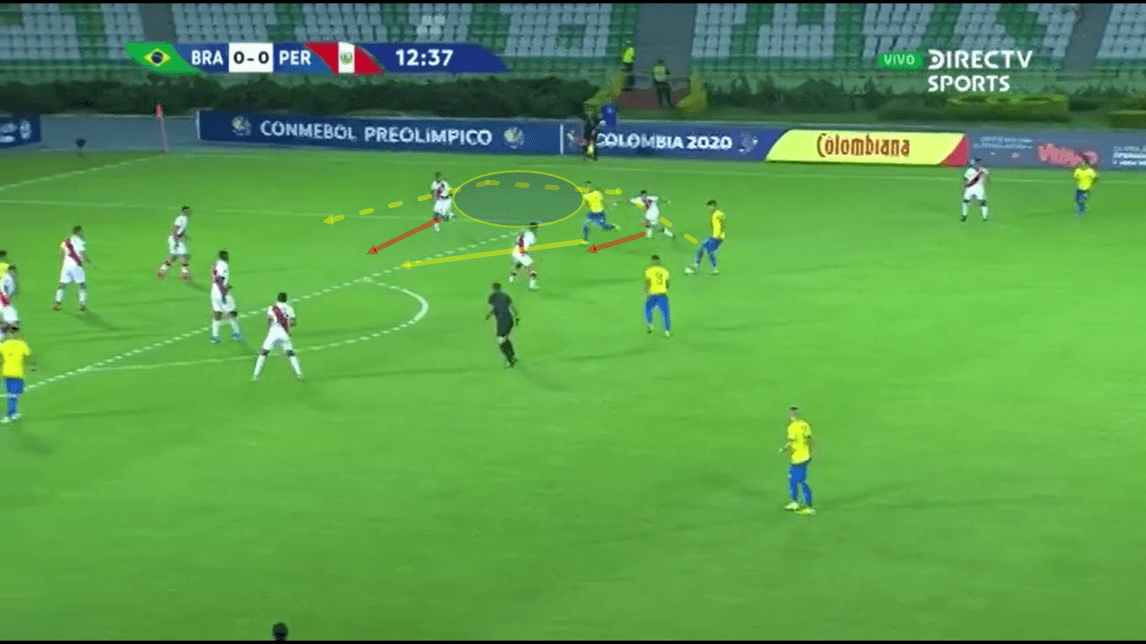
This next image provides us with one more example of Guimarães’ ball-carrying ability. However, this image provides us with an example of how Guimarães uses this ability in more advanced areas of the pitch.
As we discussed above, Guimarães is not a player who usually sits back during the attacking phase. He likes to roam forward, actively making use of his quality on the ball higher up the pitch.
Just prior to this image being taken, Guimarães received possession from the Brazilian right-winger. As we can see in this image, the right-winger subsequently makes a run between the lines into the right half-space. The dangerous run of the right-winger forces both the opposition left-back and left midfielder to follow his run inside.
This creates space on the right-wing, which Guimarães is more than happy to make use of in this passage of play. As play moves on here, Guimarães carries the ball past the opposition defence and down the right-wing. In doing so, he manages to carry the ball into the box and create a crossing opportunity for himself.
This shows us how Guimarães uses his ball-carrying ability in more attacking areas. The midfielder likes to get onto the ball high up the pitch in order to try and influence the game in the final third. This is an important aspect of his game which differentiates him from a standard holding midfielder. While he has the quality to play as a holding midfielder and often does out-of-possession, he often tends to get further forward and play as more of an ‘8’ with the ball.
Guimarães’ long-passing quality
It is clear that Guimarães’ ball-carrying ability is a big asset to his ability to progress the ball quickly as his side transition from defence to attack. However, another important aspect of Guimarães’ game, which makes him an asset in the build-up is his long-passing ability. In addition to his dribbling quality, Guimarães is capable of quickly progressing the ball up the pitch with accurate long-balls.
His technical long-passing ability combines with his positional intelligence and his eagerness to constantly seek forward passing options to make him a creative threat from deep.
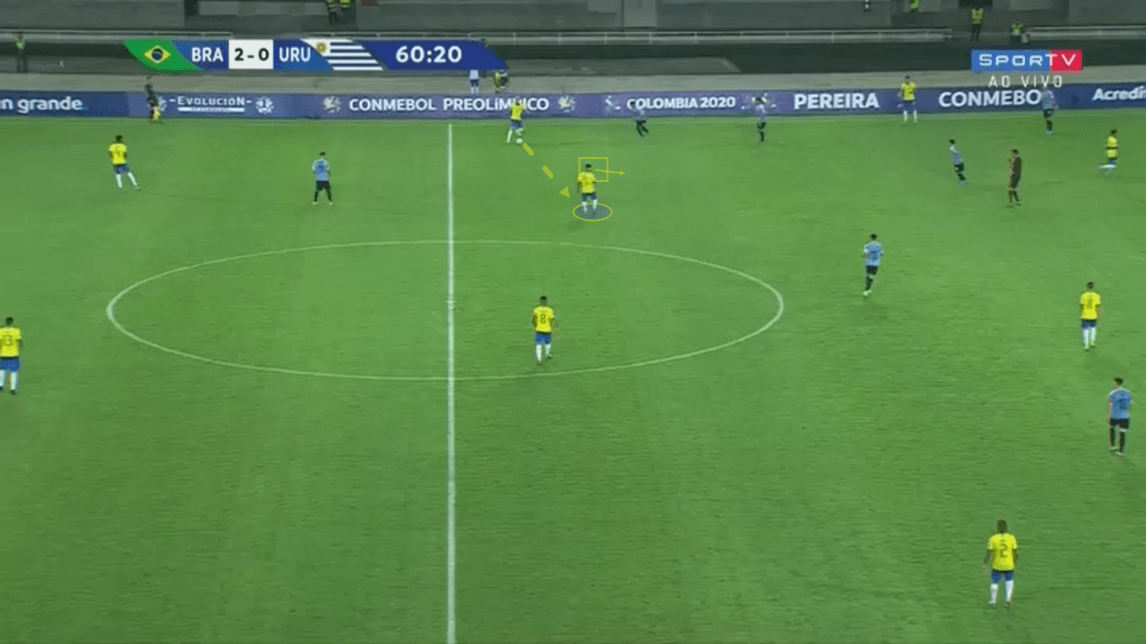
This image shows us an example of Guimarães’ quality as a deeper creative threat. Here, we can see Guimarães sitting in the centre of the pitch, enjoying a lot of space to receive the ball. He drifts slightly towards the left-wing to offer his left-back a short-passing option. He quickly receives the ball from the full-back.
Note, in this image above, we can also see Guimarães actively in the process of checking his right shoulder, prior to receiving the pass in the midfield. We can see Guimarães intelligently scanning the pitch, particularly the progressive area towards the opposition goal.
It is important for Guimarães to do this prior to receiving the ball. Firstly, this helps him to create an image of the entire pitch in his head before receiving the ball. In doing so, he can turn and pick out passing options quicker upon receiving the ball. It also gives him more time to assess the situation in his head, allowing him to make a more calculated decision upon receiving possession.
This also allows him to ensure that no opposition player is actively pressing him aggressively. This is important to know, as he can receive the ball better knowing if an opposition player is pressing him, and if so, where he is pressing him from. Guimarães is generally quite diligent with scanning in deeper areas, though at times, he can get caught out in this regard, in more advanced areas of the pitch.
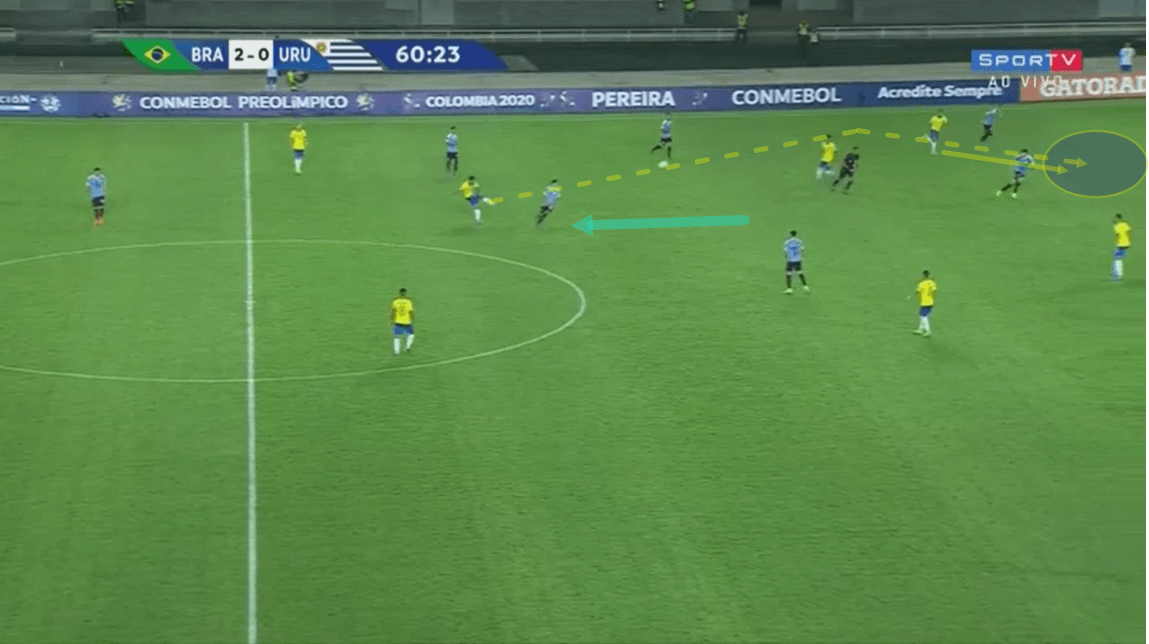
On this occasion, however, Guimarães manages to scan the area around him and receive the ball well. As we can see in this next image, this allows him to turn towards the opposition goal and curl an elegant long-ball around the opposition, landing it into the path of the probing run of his left-winger.
This passage of play provides us with an example of Guimarães’ quality as a deep playmaker. He has the ability to play intelligent and dangerous long-balls through the opposition from deep. This helps his side to quickly put the opposition goal in danger.
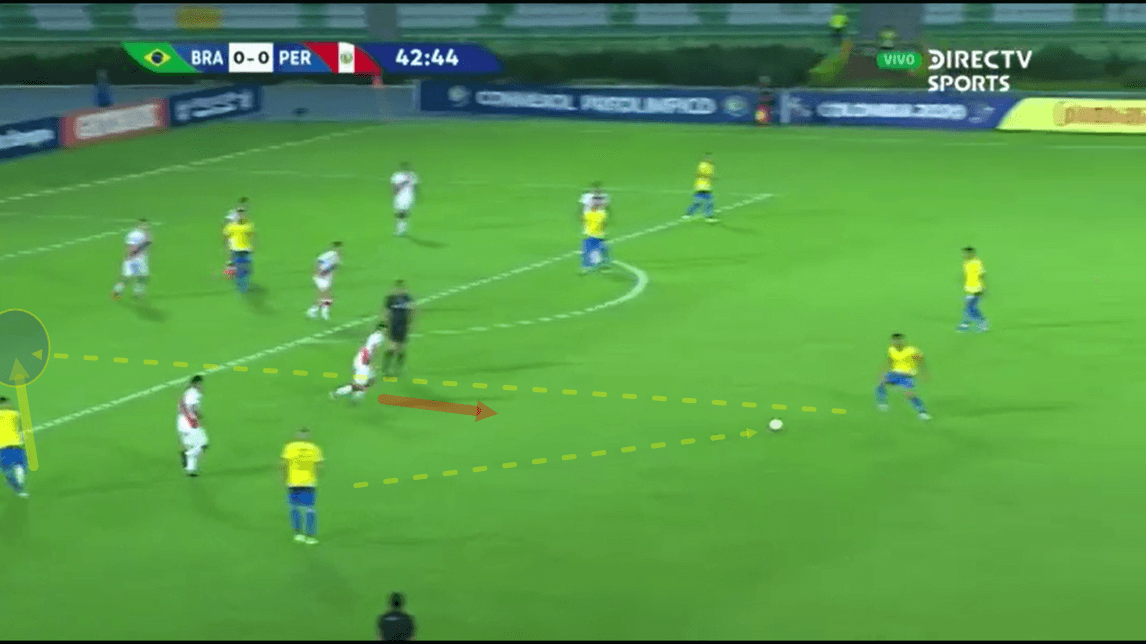
This next image shows us how Guimarães puts his playmaking quality to use in a slightly more advanced area of the pitch. As we can see, Guimarães’ Brazil side are playing against a deep Peruvian defensive block here. As his side attempt to break through the opposition block, Guimarães roams forward into a central playmaking position.
The Brazilian left-winger picks Guimarães out here, as he sees him enjoying too much space in the central area. As he plays the ball to Guimarães, he makes a run in behind Peru’s defence, which we can see here.
As Guimarães receives the ball, he attracts the press of the near Peruvian midfielder. However, Guimarães had likely already picked his pass out and quickly plays the ball through the Peruvian defensive block and into the path of the attacking run of the left-winger. This intelligent one-two results in a Brazilian goal and an assist for Guimarães.
Guimarães passing quality is clear to see. It is evident that he is capable of creating dangerous goalscoring opportunities from deep as well as in more advanced areas of the pitch through his range of passing.
Guimarães’ defensive contribution
Guimarães provides a useful option for his side in possession. His range of passing quality, as well as his ball-carrying ability, make him a big asset in possession. However, He also tends to provide his side with a sizeable defensive contribution.
As we discussed above, Guimarães often enjoys the freedom to roam forward in attack. Similarly, the energetic midfielder also often enjoys playing in the opposition half of the pitch out-of-possession. Particularly in the transition from attack to defence, Guimarães often plays aggressively without the ball as a key part of his team’s high press.
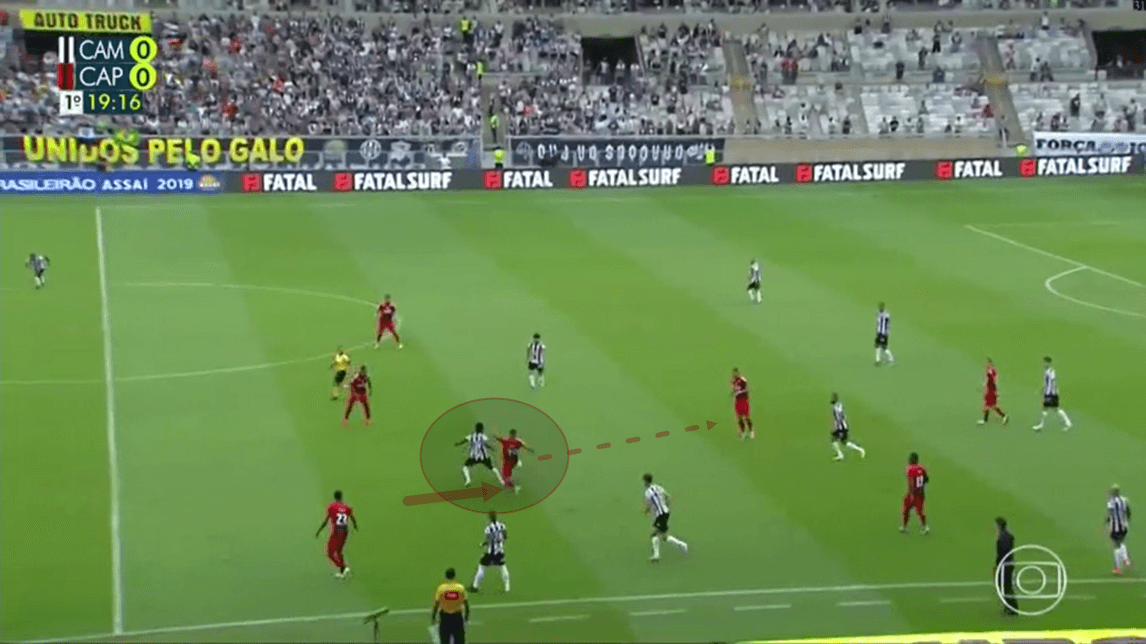
We can see an example of Guimarães’ aggressive pressing quality in this image above. Just prior to this image, the opposition, seen here wearing the black and white strip, had just won the ball back from Guimarães’ side. However, as the opposition side attempt to play the ball into the midfield area, Guimarães aggressively hounds down the ball receiver.
As he challenges the opposition midfielder, he manages to quickly win back the ball for his side. He manages to play the ball up to a more advanced attacking teammate as his side’s attack begins again. This provides us with an example of Guimarães’ effectiveness without the ball.
Guimarães is an energetic midfielder, both in and out-of-possession. As a result, he has been used extremely effectively as an ‘8’ in a counter-pressing system. Furthermore, even in deep defensive blocks, Guimarães often assumes the role of a freer, more aggressive presser of the opposition.
While Guimarães work-rate without the ball is undoubtedly an asset to his side, his eagerness to win back possession can be a detriment to his team, at times. Occasionally, due to over-committing himself in the press, Guimarães can allow himself to get beaten rather easily by the opposition. This can allow the opposition to put the defence in danger, as Guimarães’ failed press can leave gaps in the central areas when beaten.
How Guimarães may fit into Lyon’s side
Lyon have primarily used either a 4-3-3 or a 4-2-3-1 this season. We feel that Guimarães may be utilised most effectively as either one half of a double-pivot or as an ‘8’ in a three-man midfield. His ability to help his side to progress the ball from deep is a valuable asset which could be overlooked if he is deployed as an ‘8’. However, he also offers his side a lot of creativity higher up the pitch. Furthermore, his pressing quality is an asset that would suit the ‘8’ position in Lyon’s set-up.
Guimarães may fit into Lyon’s side as a replacement for Lucas Tousart. Tousart’s transfer to Hertha Berlin was confirmed shortly before Guimarães transfer to Lyon was announced. Tousart will remain with Lyon until the end of the season, however, the departing midfielder may serve solely to provide depth for the rest of the season.
Should Lyon use a 4-2-3-1, we feel that Guimarães has a natural role in the double-pivot, likely playing alongside either Thiago Mendes or the emerging young talent, Maxence Caqueret. In this role, Guimarães will help Lyon immensely in the transition from defence to attack. He will also provide a dangerous playmaking option from deep. This will be particularly dangerous with Lyon’s pacey forward line ahead of him.
In a 4-3-3, we feel that Guimarães is likely to play on the right side of central midfield. He will likely be joined by either Mendes or Caqueret at the holding midfield position, while Houssem Aouar will likely assume the left-sided central midfield position. This would likely allow Guimarães more freedom than the double-pivot role. Whatever way Lyon line-up, Guimarães’ versatility will undoubtedly be highly valued by his new team.
While he will likely take the squad position of the departing Tousart, Guimarães differs greatly from the soon-to-be Hertha Berlin man. Firstly, Guimarães is a much more progressive passer than Tousart. Tousart has played an average of just 6.61 passes into the final third, per game this season. Meanwhile, Guimarães impressively played an average of 11.98 passes into the final third this past season.
Guimarães tends to be more of a focal point in the attack than Tousart. The Brazilian received an average of 47.07 passes per game this past season. Meanwhile, Tousart has received an average of just 29.97 passes per game this season in Ligue 1.
The stats back-up Guimarães’ aggressive pressing ability also. He managed to make 62.2% of his ball recoveries in the opposition half this past season. Meanwhile, Tousart has made just 36.4% of his recoveries in the opposition half this season.
These are just some of the stand-out statistics which show the key differences between the player that Lyon can expect in Guimarães and the player that the know, in Tousart. As we stated, they are two different players and as a result, they will have a disparity in stats. However, it is clear that Guimarães is a more active playmaker than Tousart, as well as being a more aggressive ball-winner, compared to Tousart, who prefers winning the ball back in deeper areas of the pitch.
With the emergence of Caqueret, Lyon likely decided to move on Tousart. However, this also opened the door for them to introduce the promising Guimarães into the side in a new role. Guimarães’ arrival should excite Lyon fans. He will undoubtedly add an added creative spark to a side which is not exactly lacking for creativity at present.
Conclusion
To conclude this tactical analysis piece, it is clear that Guimarães is an excellent ball-carrier, a quality passer of the ball and a dangerous creative threat all over the pitch.
There are plenty of established players across Europe who share some similarities with Guimarães. One player who comes to mind when looking at the young Brazilian is Chelsea’s Mateo Kovačić. Both players are excellent ball-carriers and quality long-passers. It will be exciting to see how Guimarães continues to develop with Lyon.





Comments